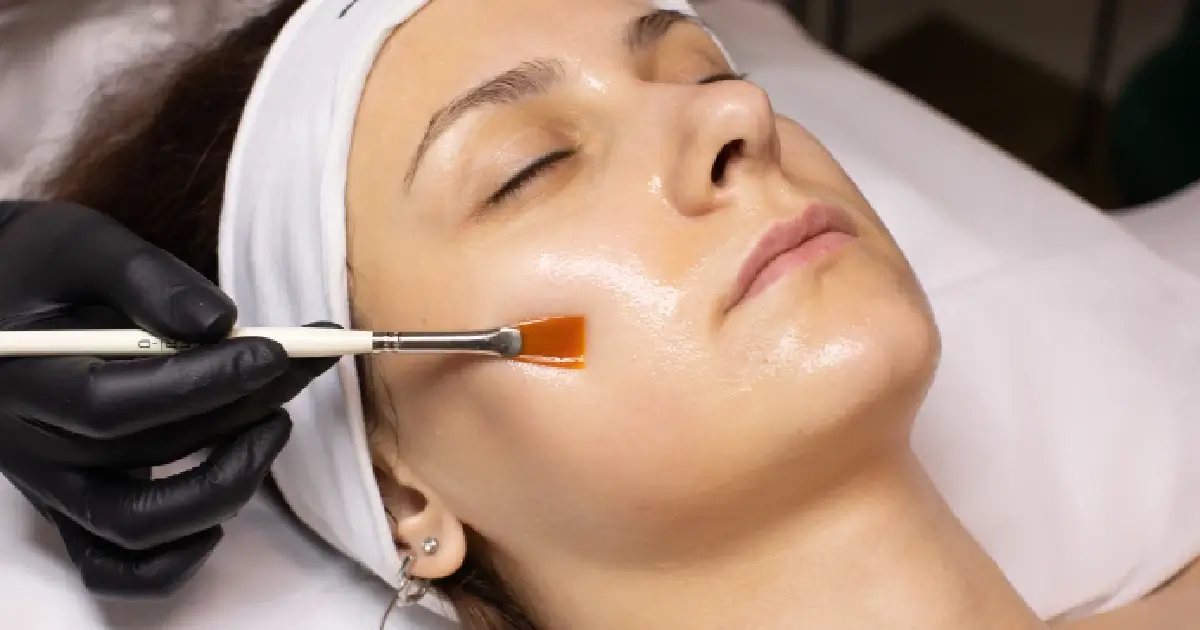Melasma, a common skin condition marked by dark, discolored patches, often presents a significant challenge in terms of effective eradication. Among the various treatments available, chemical peels have been recognized as a potentially effective approach to managing this condition. Let’s explore how chemical peels can help with melasma and what to consider before undergoing this treatment.
Understanding Melasma
Melasma is triggered by hormonal changes, such as during pregnancy or from birth control pills, and is further exacerbated by sun exposure. This condition is more common in women and often linked to genetic predispositions, particularly in those with darker skin tones. Ultraviolet light from the sun stimulates melanocytes, increasing melanin production and contributing to the development of melasma.
This skin condition manifests as dark, irregular patches, predominantly on the face in areas like the cheeks, nose bridge, forehead, chin, and upper lip. These patches vary in color from brown to gray-brown and can also appear on sun-exposed areas like the forearms and neck. The pigmentation tends to become more pronounced with sun exposure and may lighten somewhat during less sunny periods.
Diagnosing melasma typically involves a visual examination by a dermatologist, who can identify the condition based on the characteristic skin discoloration. A Wood’s lamp, emitting specific light, may be used to assess the depth of pigment changes in some cases. On rare occasions, a skin biopsy might be conducted to rule out other causes of hyperpigmentation, although this is not usually necessary.
The Role of Chemical Peels in Treating Melasma
Chemical peels play a significant role in the treatment of melasma, a skin condition marked by darkened patches, typically on the face. Here’s how they can be beneficial:
- Exfoliation of Hyperpigmented Layers: Chemical peels work by exfoliating the top layers of skin where much of the melasma pigmentation resides. This process helps in diminishing the visibility of dark patches.
- Stimulation of New Skin Growth: The removal of the outer skin layers through a chemical peel encourages the growth of new skin cells. This new skin is often less affected by melasma, leading to an overall reduction in the appearance of discoloration.
- Use of Specific Peeling Agents: Chemical peels for melasma often involve less aggressive agents, like glycolic acid or trichloroacetic acid (TCA), which are effective yet gentle on the skin. These agents help in targeting the pigmented cells without causing significant irritation or worsening of the condition.
In general, chemical peels can be a valuable tool in managing melasma, aiding in the reduction of hyperpigmentation through targeted exfoliation and regeneration of healthier, less pigmented skin cells.
The Procedure
Here’s an overview of the procedure:
- Consultation and Skin Evaluation: Before undergoing a chemical peel, a dermatologist will evaluate the patient’s skin type, condition severity, and medical history. This step is crucial to determine the most suitable type of peel and its concentration. Factors like skin sensitivity, previous treatments, and the patient’s specific goals are considered.
- Preparation: Patients may be advised to prepare their skin weeks in advance with pre-treatment creams or lotions, especially those containing retinoids or hydroquinone, to enhance results and reduce potential side effects. Sun exposure should be minimized, and the use of certain skincare products may be restricted.
- The Peel Procedure: During the procedure, the skin is first thoroughly cleansed. Then, the chosen chemical solution (like glycolic acid, trichloroacetic acid, or a combination) is carefully applied to the affected areas. The skin begins to exfoliate as a result of the solution, and depending on how intense the peel is, it may take several minutes to an hour for the skin to thoroughly peel off.
- Post-Peel Care: After the peel, the skin is usually neutralized and washed off with water. The patient might experience redness, stinging, or irritation immediately after the treatment. Post-procedure care involves using specific moisturizers, avoiding sun exposure, and applying sunscreen regularly. The skin may peel for a few days to a week after the treatment.
- Follow-Up and Results: The effectiveness of the peel in treating melasma varies based on the peel’s depth and type. Multiple sessions might be required for more significant results. It’s important to have realistic expectations and understand that while chemical peels can reduce the appearance of melasma, they might not permanently cure it. Ongoing maintenance treatments and sun protection are essential to manage melasma effectively.
Most importantly, it’s crucial to have chemical peels performed by a qualified dermatologist to minimize risks and customize the treatment to the individual’s unique needs.
Considerations Before a Chemical Peel for Melasma
Before undergoing a chemical peel for melasma, there are several important considerations to ensure the treatment is both safe and effective:
- Understanding Skin Type and Color: Chemical peels vary in intensity and can have different effects depending on your skin type and color. It’s essential to consult a dermatologist to determine if a chemical peel suits you, as certain skin types, particularly darker complexions, may be at risk of post-inflammatory hyperpigmentation or other side effects.
- Sun Protection: Sun exposure can significantly impact the results of a chemical peel for melasma. Shielding your skin from the sun is crucial before and after treatment to prevent the deterioration of melasma patches. Using a high SPF sunscreen, wearing protective clothing, and avoiding direct sun exposure are key to maintaining the results of the peel.
- Consistent Treatment Approach: Treating melasma often requires a long-term, consistent approach. A single chemical peel may not be sufficient to achieve desired results, and multiple sessions might be necessary. Additionally, managing expectations is important, as chemical peels can improve the appearance of melasma but may not completely eradicate it.
- Combining Treatments: For optimal results, chemical peels are sometimes combined with other treatments like topical creams or laser therapy. Such a combination approach, under the guidance of a skincare professional, can enhance the effectiveness of the treatment and address melasma more comprehensively.
- Post-Treatment Care: Following a chemical peel, the skin can be more sensitive and vulnerable. Proper aftercare, including using gentle skincare products, avoiding harsh chemicals, and keeping the skin moisturized, is vital for healing and preventing any complications.
By carefully taking these factors into account and working with a knowledgeable dermatologist or skincare specialist, you can decide whether a chemical peel is the right choice for your melasma and achieve the best possible outcomes.
Conclusion: The Journey of Treating Melasma with Chemical Peels
Chemical peels can reduce melasma appearance, but skin tone and texture can noticeably improve with proper guidance and a comprehensive skincare regimen. At Glow Wellness Care, under the expert guidance of Dr. Khan, we specialize in using VI Peels for efficient and painless skin treatments, effectively addressing acne, uneven skin tone, fine lines, wrinkles, scarring, age spots, sun damage, and enlarged pores. Embark on a journey with chemical peels to diminish melasma, revealing a brighter, more evenly-toned complexion.





